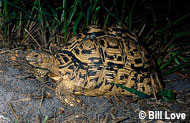Description:
There is currently one species of leopard tortoise recognized, but there are at least two distinct forms. There is a southern form and a northern form. The easiest way to distinguish the two forms is in the spotting seen on hatchlings. The southern form is going to have multiple spots on each scute and in the northern form there is going to be one or less spots on each scute. Most, if not all, of the leopard tortoises encountered today are captive bred due to heavy restrictions on exportation from the country of origin. In the United States it is no longer allowed to be imported due to a parasite (tick) the tortoise can carry which is known to carry a disease (heartwater) which is harmful to cattle. A health certificate is required to transport even captive born leopard tortoises from state to state in the United States. Leopard tortoises are very prone to respiratory problems if temperatures are not properly maintained. The most acceptable temperature range is 75 to 100 degrees Fahrenheit. These tortoises do not tolerate cold temperatures at all although the southern form is more cold tolerant than the northern form. The Leopard tortoise is a known grazer so grasses should be its main staple, but its diet can be supplemented with dark leafy greens and some fibrous fruits such as apples, pears and the like. Fresh water should be provided at all times. For more information, read our detailed leopard tortoise care sheet. .
Habitat:
Grassland, Mountain, Scrub land and semi-desert.
Range:
South Africa, East Africa (east of the Rift Valley) up to Sudan and Ethiopia.
Scientific Name: Geochelone (Stigmatochelys) pardalis
Species Group: tortoise
Family: Testudinidae
Size: 20 to 80 lbs
Level: intermediate
Weight: N/A
Dangerous: No



